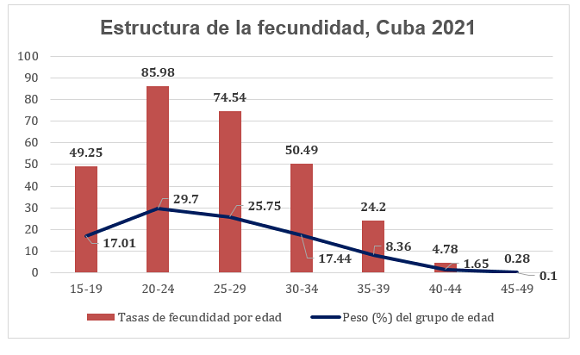
People walking along Calle 23 on January 26, 2021. Photo: Ariel Ley / ACN
At the end of 2021, more women than men lived in Cuba. The fact arouses curiosity, picaresque winks and, of course, the usual question originating in the very roots of patriarchy: how many play for each man? In any case, statistics do not go unnoticed, but as in many other matters, numbers must be looked at from the inside, scrutinized and used as a guide for other analyses.
When I closed last year, This archipelago registered 11 million 113 thousand 215 people, of which more than half -5 million 600 thousand 104- belonged to the female sex. If the demographic series of not a few nations on the planet are studied in depth, it can be easily seen that the matter is not at all strange. It was predictable and is related to a process that today distinguishes the dynamics of the Cuban population: aging.
According to an old demographic axiom, men are born more but die earlier than women. Juan Carlos Alfonso Fraga, deputy head of the National Statistics and Information Office (ONEI), has explained more than once that Globally, about 105 men are born for every 100 women.as the genetic norm of mother nature.
However, as the years go by and the …ta hill climbs, not a few population pyramids in the world show groups of women who are left alone by the grace of recklessness, wars, catastrophes and a certain biological superiority that protects them. Many of these reasons clearly have a gender bias: they stay at home more, especially at younger ages; they are less exposed to risk; by cultural heritage, they tend to be less reckless and participate less in sports or violent work, just to cite a few examples.
If the 20th century, in the opinion of specialists, turned out to be the one of the threat of overpopulation and mass births, the 21st, on the other hand, is going to be the one of aging. Slowly, but overwhelmingly, the threat of gray hair is closing in on the planet. Even countries with disproportionate population growth today see aging at the end of the road.
It is estimated that the share of the global population aged 65 and over will rise from 10 percent in 2022 to 16 percent in 2050, according to the World Population Prospects 2022 report, published by the United Nations. By then, it is expected the number of people over 65 in the world will far exceed the number of girls and children under 5 years of age, and will equal the population of children under 12 years of age.
In 2015, more women than men populated the planet; right now, in mid-2022, that reality has changed and the male population represents 50.5 percent of the total population of the world which, according to calculations by the United Nations Population Fund (UNFPA), should round up to 8 billion in November.
The comparison helps to understand one of the alerts that UNFPA itself raised this July, when it commemorated, as every year, World Population Day: “… it is time to reflect and for all countries to take stock and promote actions, regardless of the direction of its population growth.
In other words, in plain words, accounts without context are not going to help find the multiple solutions demanded by the large number of diverse people who live together on the planet today. “The population story is much richer and more nuanced than one number alone can capture,” UNFPA insisted.
“But this does not mean that we stop counting. Each country must anticipate and understand how its population is changing to achieve the world we aspire to.”
beyond the accounts
Following the UNFPA route, what exactly does the fact mean that, for every thousand women, in Cuba we now have 984 men? How old are these Cuban women, where do they live, what are their challenges?
A look at three recent data sets of the Cuban population, among many possible, can give us some clues to continue investigating.
The hyped-up female numerical superiority, for example, has differentials by age. In other words, it is concentrated in the older ages of life.
As the demographer quoted at the beginning of these Letters referred to…, more men are born here -Up to 14 years of age, the male population represents 51.61 percent of the total-; this proportion tends to balance out at intermediate ages, but after the age of 60, women make up 54.05 percent of that group of people.

Image: ONEI.
How to interpret these data? Just by putting some common sense into them, a first glance tells us that where the female population is larger, strategies should be drawn up to attend to, for example, the morbidities that most affect it and that contribute the most to the main causes of death in the country. In the case of women we are talking, just to give an example, of diabetes mellitus, obesity or some types of malignant tumors, according to additional clues that can be found in the Health Statistics Yearbook.
But also that in those intermediate ages where they almost reach in proportion to their peers, those Cuban women are concentrated, who are the majority among professionals and technicians, have a high participation in state employment and carry on their shoulders the double and triple burdens of care and work unpaid.
Changing the magnifying glass, if we turn our eyes to the population of working age, the most general figure shows us that, on this island, it is mostly male. They represent only 47.48 percent of those who made up that group of people at the end of 2021. However, in urban areas the proportion of women of working age grows to just over 48.5 percent, while in rural areas it falls to 44.08 percent. One possible interpretation refers to the spatial mobility of the population. More and more women than men are moving from the Cuban countryside to the more urbanized areas.
And if we turn our eyes towards fertility, the numbers tell us much more than what is already known. The rates of this indicator in Cuba, it is already known, are very low; one of the reasons that is intertwined with the behavior of other demographic variables to explain the acute aging process.
Between 2019 and 2021, the global fertility rate fell from 1.57 to 1.45 children per woman. However, a look at the age structure of that fertility reveals that it is women between 20 and 29 years of age who contribute the most to births in the country; but also that it is time to pay attention and take urgent action on adolescent pregnancy, since girls under 19 years of age are responsible for around 17 percent of the fertility of the patio.
Research from the Center for Demographic Studies (CEDEM) corroborates this conclusion obtained at the point of numbers. In the opinion of Dr. Matilde Molina Cintra, deputy director of that academic institution, adolescent fertility is resisting the decline and although in these last two years marked by the COVID-19 pandemic, its level decreased slightly, its weight in the country’s fertility structure has increased, in relation to other age groups and its heterogeneity has increased according to zones and municipalities. If 5 years ago births to mothers at an early age showed a high concentration in the eastern region of the country, today that reality is changing and high indicators can be seen in other provinces and municipalities.

Image: ONEI.
Each country must have the information it requires to meet the needs of various population groups and ensure that people can develop their full potential, UNFPA recommends.
In Cuba, since May 2020, the creation of Demographic Observatories in all the provinces and municipalities of the country is looking at each specific context. The numbers do not say the same in La Sierpe, Contramaestre or Los Palacios. And right now, those structures born by resolution of the Prime Minister of the Republic, attached to governments and with technical advice from CEDEM; they are confirming it on a daily basis.
UNFPA calls this ability to understand how populations change in order to design social policies and responses tailored to each context demographic resilience. And it is also directly related to the need to rethink traditional norms, especially those related to the roles of women and men in families and societies, which prevent turning demographic challenges into opportunities.
Counting then, transcends the mere mathematical exercise and becomes a first step to guide the course.
Statistics taken from the Population Interfaces, the Integrated System of Demographic Consultations (SICDEMO), ONEI.
